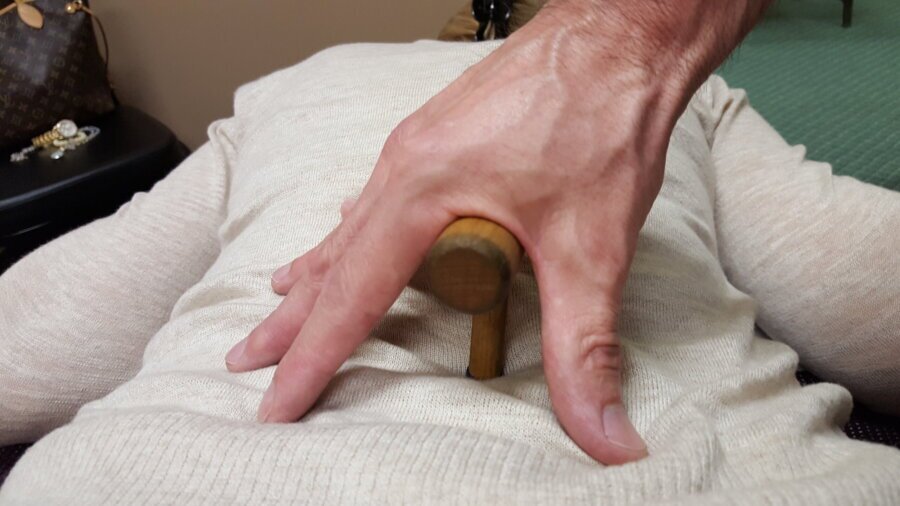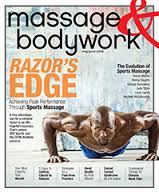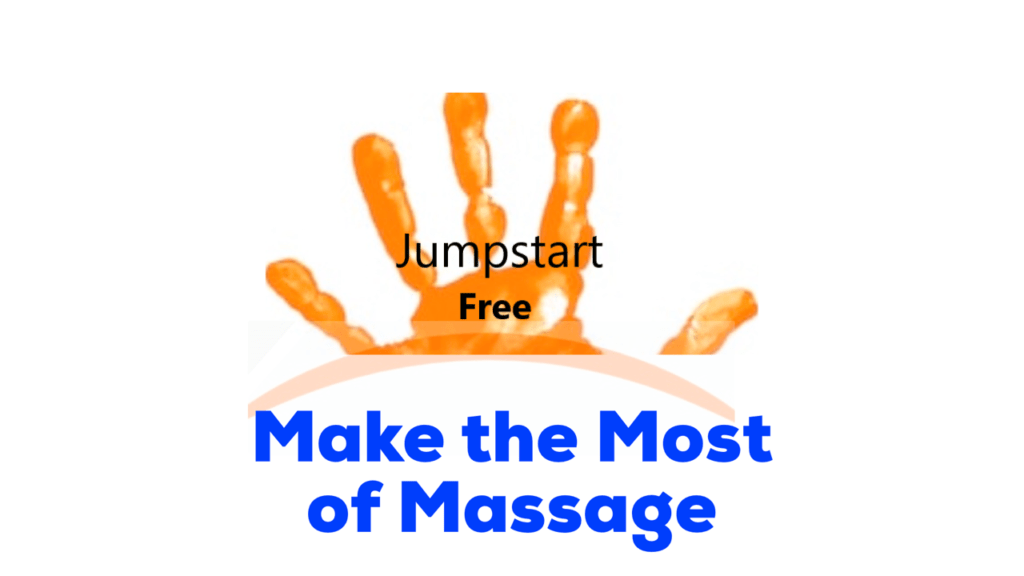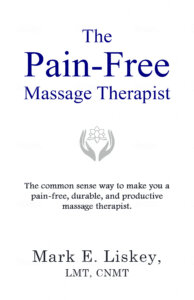I’d bet $100 that you’ve experienced this at least once in your massage career: thumb pain.
And my guess is that the next thing you do is to search YouTube videos for thumb massages and stretches.
But instead of just managing thumb pain, why not stop injuring thumbs altogether?
And burn out my fingers instead, Mark?
No.
Use a T-bar instead of thumbs and fingers.
But there’s a caveat here. A T-bar can actually hurt your hand if you don’t understand some basic things about holding it.
The T-bar Structure
The T-bar can be broken down into three elements: the handle, the shank and the tip.

The shank is in the middle of the handle. The tip of the shank can be flat or have rounded edges. Here the tip is covered by a plastic end-cap. Other options include a rubber end cap or no end cap at all, just bare wood.
As you can see, it’s a very simple tool. But a simple tool can be a highly effective tool. And that’s what I discovered when I first got my hands on a T-bar.
St. John’s Neuromuscular Therapy
I was introduced to the T-bar in 1998 when studying Paul St. John’s neuromuscular therapy (NMT). A tenet of NMT was to work the origin and insertions of muscles. To do this, you needed to be able to apply very precise and often deep pressure. Thumbs, of course, were a natural fit for this job.
However, thumbs would take a pounding if you tried to use them for deep work in dense muscle areas like in the spinal lamina groove. Enter the trusty T-bar.
When I first tried using a T-bar during a neuromuscular class, I was instantly hooked. Though it felt clunky in my hands, I was able to generate precise pressure like never before without thumb pain.
After I was certified in NMT, I opened a practice. But a few years into the business, something unexpected happened: My hands hurt.
I Didn’t Want to Quit Massage
At first I thought I’m simply coming up to one of the reasons why MTs change careers—pain and injury.
But at the same time, I was having non-massage, pain issues, too. A lot of my non-massage pain was due to bad techniques when working out. I decided to make some changes in the gym and those issues got better.
So, I then took another look at my hand pain. It seemed to occur after I was using the T-bar. This made me wonder if I could eliminate my hand pain by adjusting something that I was doing when using the T-bar.
The short answer was yes. And it all started with my intention.
How My Thumb Pain Went Bye-Byes
At the time, my intention when using the T-bar during a massage was to work a tender/tight spot with precision.
But there was a vital part missing to this intention. The missing part was “without causing me (the massage therapist) pain.”
That may sound obvious, but think of all the times you did a particular massage technique to release a muscle, knowing that it was causing or was going to cause you pain?
It’s just what we do.
So, keeping this idea of “not being in pain when working” in mind, I zoomed in on how I was holding the T-bar. It soon became apparent that I was over-gripping the T-bar, and that was probably the cause of my hand pain.
Adjustment 1: Relax Your Hand
This is how we were taught to grip a T-bar in NMT class.

Take note of my fingers gripping the stem and tip to control the T-bar.
This hold allowed you to have fine-tuned control of the T-bar when working a tight/tender spot, but it also encouraged you to grip the T-bar tightly, even when applying light pressure.
Hmm, I wondered, what would happen if I just loosened my grip some?
Actually, nothing happened. The T-bar didn’t slip out of my hand, and I was still able to control the tip with a lighter grip.
This begged the question: How loose can I hold the T-bar without it actually falling out of my hand? I started experimenting and found that my hands were very happy when I simply steadied the T-bar with the minimal amount of pressure required to keep the T-bar from dropping or slipping from my hand.
This is a loose-hand hold: 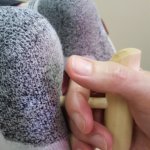
My fingers are relaxed and I’m using just enough of a grip so that T-bar doesn’t slip out of my hand.
At the end of a month or so, I got pretty good with light and medium pressure, but when I ratcheted up to deep, I had to tighten the grip to keep the tool steady.
I wish I could say that I figured out the pain-free method of holding a T-bar for deep pressure within a month or so, but I can’t.
In fact, I went in a different direction altogether. I started experimenting with other massage tools for deep and precise pressure. And it wasn’t until 15 years later that I figured out how to use the T-bar for deep pressure without hurting my hands.
At that time, shoulder and neck conditions forced me to radically change my massage body mechanics. One of the big changes that I made was to set my table lower than I normally had it. And when I did, the T-bar missing puzzle piece fell into place.
Adjustment #2: Pin the T-bar
With a lower table, my work was below me. This meant that I could take full advantage of leaning my body weight into the client to generate pressure.
When I leaned in with a T-bar to do deep pressure, I could pin the T-bar between my hand and the client’s body. There was no need to grip hard to hold the T-bar in place. In fact, I really didn’t have to grip at all. This is an open-hand hold.

To execute this hold the table has to be low enough so that you can lean in to generate pressure and pin the T-bar. Here’s what it looks like when the camera steps back.
The pin technique made it easy to hold the T-bar, but there were times when a one-handed pin wasn’t possible and/or my pinning hand needed a break. This leads us to the third adjustment.
Adjustment #3: Use A Guide Hand Next to the T-bar
Using a guide hand next to a T-bar is my preferred way to hold a T-bar.
For one, I’m contacting the client with more surface area than I would with the T-bar alone. This gives the massage more of a relaxation feel.
Two, it’s really easy to stabilize the T-bar with a guide hand, maintain sensitivity and regulate pressure.
Three, I can shift the emphasis of pressure from tool to guide hand (hand not holding the T-bar) without having to pull my hands off the client.
In this picture my guide hand is a relaxed fist. 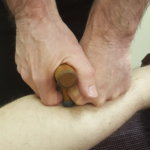
The relaxed-fist, guide hand that’s next to the T-bar serves as a stabilizer. For broader pressure, I would direct more of my body weight into my fist. For precise pressure, I’d lean more into the T-bar. This hold is great for calves and forearms.
This next example is a double-handed hold.

Note that both hands are contacting the handle. Having two hands on the handle allows me to lean in with my body weight. I use this hold when I need to deliver more pressure to influence deep muscles.
The double-handed hold is good for when you’re working thick areas, like back, hamstrings and quads.
Also, can you see that my hands are relaxed? That’s really important because you’ll instinctively want to tighten your grip to steady the T-bar as you lean in to deliver deeper pressure.
But that’ll be completely unnecessary. Look at all the points of contact my fingers and knuckles make with my client’s back. That T-bar is not going anywhere!
This last hold is a wrap-around technique that works well feet.
The great thing about the wrap-around hold is that it’s easy to control your pressure. You simply lean in. 
The guide-hand and two-handed holds worked great for me, but I had a tendency to get really comfortable with one or two holds and I then I’d feel the overuse pain again. This tendency led to me to adjustment #4.
Adjustment 4: Vary Your Holds
There are countless ways to hold a T-bar. Here’s how I recommend you experiment. First, pin the T-bar between your hand and the client’s body. Then place your other hand next to the T-bar and allow that hand do whatever it wants to in order to support the T-bar.
Just remember to keep your hands relaxed and you’ll be amazed at how many different holds you’ll come up with.
Easier than You Think
There’s a potential irony in massage that we all desperately try to avoid. It goes like this: We put ourselves in pain to get someone else out of pain.
Thumb pain is not a byproduct of doing massage.
Kick thumb pain to the curb by using a T-bar when doing deep and precise work. But first you have to learn how to hold the T-bar without gripping it.
Here are the keys for holding a T-bar:
- Hold the T-bar with a relaxed hand.
- Pin the T-bar between your hand and the muscle by leaning in. You may have to lower your table. You can lean when you’re sitting, too.
- Use a guide hand, thumb, finger next to the T-bar for stability, sensitivity and as a pressure gauge.
- Use two-handed holds to spread the workload.
- Vary your holds so that you don’t overuse a body part.
Once you get these basic things down, you’ll never have to worry about developing chronic thumb pain again.
Looking to get a T-bar?
For a plastic one, check out CareerExtenders.
For a wooden T-bar, visit NeuromuscularSolutions.
Want a custom T-bar?
Call/text my friend Matt Johnson: 610-945-6491.
He makes all my wooden massage tools. Prices range between $15 and $25 per T-bar.
Want to Get Good with Massage Tools?
 Do it with one online, home-study class and some practice.
Do it with one online, home-study class and some practice.
This is the online, home-study class that I’ve designed to get you comfortable with using a massage tool in any massage you do: How to Use Massage Tools (Fearlessly and Effectively).
This class takes massage tools to the next level so that you can brand yourself as an expert with focused pressure: Advanced Massage Tools.
